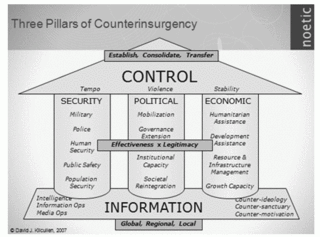According to a RAND Corporation release today, a major new, 178-page study rates the performance of 20 distinct approaches to counterinsurgency operations against 30 recent insurgencies around the globe between 1978 and 2008.

The project was sponsored by the Office of the Secretary of
Defense, Cost Analysis and Program Evaluation, Irregular Warfare
Division.
"Too much of the current debate on counterinsurgency relies on one or
two arbitrarily selected cases or a general sense of history," said Christopher
Paul, lead author of the study and a social scientist at RAND, a
nonprofit research organization. "This study used 30 systematically
selected and analyzed cases to reach some findings that support the
conventional wisdom, and some that are more surprising."
For example, winning a counterinsurgency campaign doesn't hinge on a
single factor. The armed forces that succeed in counterinsurgency
operations typically implement a host of identified good
counterinsurgency practices while avoiding ineffective ones. More
surprising, however, is that this finding holds across all 30 cases
studied.
Every counterinsurgency "win"—eight out of 30 cases—had a strongly
positive balance of successfully implemented good versus detrimental
factors and every counterinsurgency loss had a zero or negative balance
of good versus detrimental factors. Researchers say this suggests that
while every insurgency may be unique in its specific context and local
conditions, the kinds of things that counterinsurgents should be trying
to do are consistent across cases.
Of the 20 counterinsurgency approaches tested, 13 received strong
empirical support, while three approaches—resettlement, escalating
repression and various insurgent support strategies—have the weight of
evidence against them. Some of the counterinsurgency approaches
validated by this study include those advocated in Army Field Manual
3-24 (Counterinsurgency). Those strategies include what would now be
called strategic communication and several classic approaches to
counterinsurgency, including pacification and legitimacy.
While some repressive counterinsurgency forces have managed to prevail,
the study found that repression is a bad counterinsurgency practice.
Only two of eight winning counterinsurgency campaigns (those in Turkey
and Croatia) used escalating repression and collective punishment during
the decisive phase of the conflict. However, in those two cases the
counterinsurgents simultaneously employed a much larger number of good
counterinsurgency practices.
Repression was shown to win intermediate phases, but a substantial
majority of phases in which the counterinsurgents seized the upper hand
through repression preceded an ultimate defeat, including insurgencies
in Somalia, Burundi, Tajikistan and Kosovo.
Popular support was found to be an important contributor to insurgency
outcomes. However, tangible support—the ability of insurgents to
replenish and obtain personnel, materiel financing, intelligence and
sanctuary—was found to be even more important than popular support.
While popular support and tangible support often followed each other in
the cases studied —if the insurgents had the support of the population,
they were able to meet their tangible support needs; if they lacked
popular support, they were not—when popular support and tangible support
diverged, victory followed tangible support. Because of this, the study
recommends counterinsurgents identify the specific tangible support
needs and sources of insurgents and target them in addition to wooing
the population in the area of conflict.
The study recommends that counterinsurgency operations should plan to
pursue multiple, mutually supporting lines of operation, and build and
maintain forces capable of engaging in multifaceted operations.
Several of the good counterinsurgency practices depend on the nature and
behavior of the host nation government, so if a government or its
structure or policies do not conform with good counterinsurgency
practices, improvement should be a top priority. Also, the United States
"should think twice before choosing to support governments that will
not help themselves," Paul said.
While there is no hard and fast threshold for the minimum number of good
counterinsurgency practices a force must use in order to win,
counterinsurgents should keep a scorecard of good versus bad factors and
practices. If the balance of good and bad factors is not positive, that
suggests counterinsurgents should adjust strategies or make changes in
their implementation or execution.














Recent Comments